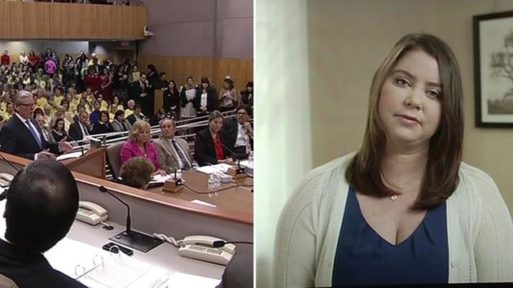Today SevenPonds speaks with Sarah Hooper, the Executive Director of the UCSF/UC Hastings Consortium on Law, Science & Health Policy and Adjunct Professor of Law at UC Hastings College of the Law in San Francisco, California. A recognized expert in medical-legal issues in the area of end-of-life decision making, Sarah has been instrumental in providing clarity around California’s recently implemented End of Life Options Act for both medical professionals and the public at large. Today, she offers us her insights into the new law and its anticipated impact in the state.

Sarah Hooper
Credit UCSF
Kathleen: Thanks so much for speaking with me today, Sarah. I’d like to start out by asking you a little bit about your involvement with the End of Life Options Act. Were you instrumental in drafting the law?
Sarah: No, not at all. I and my colleagues at the Consortium of Law, Science & Health Policy have followed the law closely as it moved through the legislative process, but we were not directly involved in drafting the law or lobbying for or against it. As public educators, our responsibility is to provide information and guidance on the End of Life Options Act now that it has been signed into law by Gov. Brown.
Kathleen: So your role is primarily public education and interpreting public policy?
Sarah: Primarily, yes. The consortium was formed initially as a means of integrating the various disciplines involved in research, policy-making and policy implementation in the areas of elder care, health-care decision-making and end of life. Early in my career, I realized that these issues transcend professional boundaries, and I wanted to help facilitate a more integrated approach to the extraordinarily complex bioethical issues involved. I worked closely with Rebecca Sudore, who has been a pioneer in promoting Advance Health Care Directives and end-of-life planning. This has evolved into a greater emphasis on outreach and public education.
Kathleen: The End of Life Options Act, which gives terminally ill patients in California the right to end their own lives with the help of a physician, was a very hotly debated piece of legislation. Some disability advocacy groups, in particular, objected strongly to the law. What were some of their objections, and do you think there is validity to their concerns?
Sarah: The main concern articulated by those who object to the law is the fear that the process could be abused — that the elderly and the disabled could be pressured into choosing to end their own lives. However, the statute clearly addresses that issue with many built-in safeguards, including a very precise definition of who is eligible to take advantage of the law.
Kathleen: The law only allows persons with a life expectancy of under six months to request aid in dying, is that correct?
Sarah: Yes. The person must have a terminal illness and the prognosis must be certified by two physicians, both of whom must be experts in the patient’s disease. So, for example, if the person requesting aid in dying has cancer, two oncologists must state that his disease is terminal and his life expectancy is six months or less.

Gov. Brown signs the End of Life Options Act
(Credit: vice.com)
Kathleen: Are there other safeguards in place that protect patients who may feel that they are being pressured by others to end their own lives?
Sarah: Yes, there are quite a few. First, patients who wish to request aid in dying must make the request verbally to their attending physician. At that time, the physician is required to ask them if anyone has tried to influence their decision and counsel them on other options that are available, such as hospice and palliative care, social services, and options for managing physical pain. Then the patient must wait at least 15 days and make the verbal request again. After that, they are required to put the request in writing. It’s a long process that requires a great deal of documentation by the patient and the physician, all of which is intended to ensure that the patient is fully informed about their options and is making the request voluntarily.
Kathleen: Some who object to the law believe that it sends the message that life is not worth living if you have a terminal illness. How would you respond to this?
Sarah: In my opinion, that’s a misguided view. People who choose aid in dying want to live, but that option has been taken away from them. They are not choosing whether to live or die: They are choosing the timing and manner of their deaths.
With that said, I also believe that we as a society do not protect vulnerable populations as well as we can or should. We are making progress with things like hospice, palliative care, and long-term care, but we are still a long way from providing the full spectrum of support services that is needed to help those who are nearing the end of life live in a manner that’s consistent with their wishes and their needs.

Credit: UCSF
Kathleen: California’s law was modeled after Oregon’s Death with Dignity Act, which has been in effect for nearly 20 years. Can you speak to how the law has played out in that state?
Sarah: Certainly. There’s now a great deal of data available as to who is taking advantage of Oregon’s law, and the vast majority of those who do so are well-educated, fairly affluent, and white. Over 90 percent of patients who chose to end their lives were enrolled in hospice at the time they ingested the medication, and most chose to die at home. The most common diagnosis among patients who chose physician-assisted death was cancer, followed by amyotrophic lateral sclerosis, or ALS.
Kathleen: I believe some groups who opposed the California law expressed concern that insurance companies might place implicit pressure on patients to end their lives by denying certain expensive therapies (for example, experimental cancer drugs) while simultaneously informing the patient about the availability of physician assisted death (which reportedly happened in Oregon). Does the California law address this concern?
Sarah: The law addresses that concern by specifically prohibiting insurance companies from informing patients of the option of physician assisted death.
Kathleen: How expensive are the medications typically used in physician assisted death, and do insurance companies typically cover the cost?
Sarah: The End of Life Options Act doesn’t specify what medication or combination of medications doctors ought to prescribe to patients seeking aid in dying, so the cost is difficult to estimate. In Oregon, the most commonly prescribed aid-in-dying drug is secobarbital given in combination with a medication to prevent nausea and vomiting. The cost of two drugs ranges from $1,500 to $3,000.
Some private insurers cover the cost of the medications used in physician assisted death, while others do not. Patients who are interested in taking advantage of the law should contact their insurance companies directly to determine what their out-of-pocket costs will be. Medicare, which is a federally funded program, will not pay for aid-in-dying medications, and Veterans Administration facilities are barred from participating. But MediCal, California’s low-income health plan, says they will pay some portion of the cost.

Brittany Maynard’s videotaped testimony before the California legislature was instrumental in getting the End of Life Options Act passed. Brittany left California for Oregon to take advantage of physician assisted death after being diagnosed with a brain tumor at the age of 29.
(Credit: abc news.com)
Kathleen: I understand that physicians are not required to participate in aid in dying. Additionally, entire institutions can “opt-out,” essentially preventing any healthcare professional employed by the institution from participating in the practice. How do you see this impacting patients who want to take advantage of the law?
Sarah: Theoretically, it could be problematic, particularly for those who live in rural areas served by a limited number of healthcare providers. However, many of the largest healthcare organizations in California have stated that they will participate in some way. With that said, each organization is free to create its own guidelines around how it will implement the law. For example, some providers, such as UCSF, have decided to require mental health evaluations for all patients who request aid-in-dying, although those evaluations are not mandated by law. Others will not allow the medicine to be ingested on the premises, which could present significant barriers for patients who are being cared for in a hospital or other inpatient facility.
Another issue that may become problematic is the fact that not all providers in the same institution will choose to participate, which can create barriers as well. For example, a patient with cancer who requests aid in dying must see two oncologists and, in some cases, a mental health professional. Participation by other staff, such as social workers and interpreters, may be required as well. If only a small number of providers in a given institution choose to participate, patients could face long delays in getting the consultations and approvals they need. For patients who are facing imminent death, these delays could effectively prevent them from taking advantage of the physician aid in dying at all.
Kathleen: On that note, Sarah, what tips or advice can you provide to our readers who may be interested in taking advantage of physician aid in dying, if not immediately, then at some point in their lives?

Credit: UCSF
Sarah: From my perspective, one of the biggest benefits of the End of Life Options Act is that it has served to open up conversations about end of life care. Many physicians are still very reluctant to begin these discussions with their patients, and this legislation provides a clear path for patients whose health is on a downward trajectory to initiate discussions about their long term goals.
Of course, before patients begin a conversation with their doctors, they need to determine what they do and do not want as they approach the end of their lives. How and where do they wish to be cared for as their ability to care for themselves independently deteriorates? How much medical intervention do they want as they near death? Where do they wish to spend their last days?
All of these things should be discussed with their loved ones and written into an Advance Directive for Healthcare and, if appropriate, a Prehospital Do Not Resuscitate form. The clearer each of us is about our wishes, the more likely it is that our needs will be met.
Kathleen: One final question, Sarah. Where can our readers go to find about more about the law?
Sarah: Readers can do to our website to find detailed information about the End of Life Options Act, including the full text of the law.
Kathleen: Thanks so much Sarah. It’s been a pleasure speaking with you!
Listen as Sarah discusses the End of Life Options Act in detail in the video below.

 What Are Some Implications of the California End of Life Options Act? An Interview with Sarah Hooper
What Are Some Implications of the California End of Life Options Act? An Interview with Sarah Hooper


 First the Wealth Gap, Now the U.S. Has a Growing Health Gap
First the Wealth Gap, Now the U.S. Has a Growing Health Gap

 Our Annual Seven Holiday Gifts for Someone Who Is Grieving, 2024 Edition
Our Annual Seven Holiday Gifts for Someone Who Is Grieving, 2024 Edition














